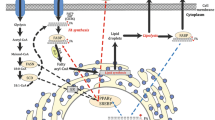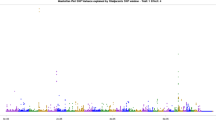Abstract
We examined the gene–gene interactions of five exonic single nucleotide polymorphisms (SNPs) in the gene encoding fatty acid synthase using 513 Korean cattle and using the model free and the non-parametrical multifactor dimensionality reduction method for the analysis. The five SNPs of g.12870 T>C, g.13126 T>C, g.15532 C>A, g.16907 T>C and g.17924 G>A associated with a variety of fatty acid compositions and marbling score were used in this study. The two-factor interaction between g.13126 T>C and g.15532 C>A had the highest training-balanced among the five-factor models and a testing-balanced accuracy at 70.18 % on C18:1 with a cross-validation consistency of 10 out of 10. Also, the two-factor interaction between g.13126 T>C and g.15532 C>A had the highest testing-balanced accuracy at 68.59 % with a 10 out of 10 cross-validation consistency, than any other models on MUFA. In MS, a single SNP g.15532 C>A had the best accuracy at 58.85 % and the two-factor interaction model g.12870 T>C and g.15532 C>A had the highest testing-balanced accuracy at 64.00 %. The three-factor interaction model g.12870 T>C, g.13126 T>C and g.15532 C>A was recorded as having a high testing-balanced accuracy of 63.24 %, but it was lower than the two-factor interaction model. We used likelihood ratio tests for interaction, and Chi square tests to validate our results, with all tests showing statistical significance. We also compared this with mean scores between the high-risk trait group and low-risk trait group. The genotypes of TTCA, TTAA and TCAA at g.15532 and g.13126 on C18:1, genotypes TTCC, TTCA, TTAA, TCAA CCAA at g.15532 and g.13126 on MUFA and genotypes CCCC, TCCA, CCCA, TTAA, TCAA and CCAA at g.15532 and g.12870 on MS were recommended for the genetic improvement of beef quality.

Similar content being viewed by others
References
Miyazaki M, Dobrzyn A, Man WC, Chu K, Sampath HH, Westerling DB, Hedrick HB (1979) Fatty acid composition of bovine lipids as influenced by diet, sex and anatomical location and relationship to sensory characteristics. J Anim Sci 48:1343–1344
Melton SL, Amiri M, Davis GW, Backus WR (1982) Flavor and chemical characteristics of ground beef from grass-, forage-grain and grain-finished steers. J Anim Sci 55:77–87
Matsumoto N, Kakihara F, Kimura S, Kurebayashi Y, Hirai M, Yohda M, Hasegawa S (2007) Single nucleotide polymorphism genotyping of CYP2C19 using a new automated system. Anal Biochem 370:121–123
Mandell IB, Buchanan-Smith JG, Campbell CP (1998) Effects of forage vs grain feeding on carcass characteristics, fatty acid composition, and beef quality in Limousin-cross steers when time on feed is controlled. J Anim Sci 76:2619–2630
Inoue K, Shoji N, Kobayashi M (2008) Genetic relations among fat melting point, fatty acid composition and carcass traits in Japanese Black cattle. Nihon Chikusan Gakkaiho 79(1):1–8
Roy R, Taourit S, Zaragoza P, Eggen A, Rodellar C (2005) Genomic structure and alternative transcript of bovine fatty acid synthase gene (FASN): comparative analysis of the FASN gene between monogastric and ruminant species. Cytogenet Genome Res 111:65–73
Oh D, Lee Y, La B, Yeo J, Chung E, Kim Y, Lee C (2012) Fatty acid composition of beef is associated with exonic nucleotide variants of the gene encoding FASN. Mol Biol Rep 39:4083–4090
Morris CA, Cullen NG, Glass BC, Hyndman DL, Manley TR, Hickey SM, McEwan JC, Pitchford WS, Bottema CD, Lee MA (2007) Fatty acid synthase effects on bovine adipose fat and milk fat. Mamm Genome 18:64–74
Abe T, Saburi J, Hasebe H, Nakagawa T, Misumi S, Nade T, Nakajima H, Shoji N, Kobayashi M, Kobayashi E (2009) Novel mutations of the FASN gene and their effect on fatty acid composition in Japanese black beef. Biochem Genet 47:397–411
Zhang S, Knight TJ, Reecy JM, Beitz DC (2008) DNA polymorphisms in bovine fatty acid synthase are associated with beef fatty acid composition. Anim Genet 39:62–70
Henderson CR (1976) A simple method for computing the inverse of a numerator relationship matrix used in predicting of breeding values. Biometrics 32:69–83
Ritchie MD, Hahn LW, Roodi N, Bailey LR, Dupont WD, Parl FF, Moore JH (2001) Multifactor-dimensionality reduction reveals high-order interactions among estrogen- metabolism genes in sporadic breast cancer. Am J Hum Genet 69(1):138–147
Chung YJ, Lee SY, Park TS (2006) Multifactor dimensionality reduction in the presence of missing observations. In: Proceedings of the 2006 Spring Korean Statistical Society Conference, Pusan National University, Pusan, 31–36
Bastione L, Reilly M, Rader DJ, Foulkes AS (2004) MDR and PRP: a comparison of methods for high-order genotype-phenotype associations. Hum Hered 58:82–92
Folch J, Lee M, Sloane Stanley GH (1957) A simple method for the isolation and purification of total lipids from animal tissue. J Biol Chem 226:497–509
O’Keefe PW, Wellington GH, Mattick LR, Stouffer JR (1968) Composition of bovine muscle lipids at various carcass locations. J Food Sci 33:188–192
Vreeland WN, Meagher RJ, Barron AE (2002) Multiplexed, high throughput genotype by single-base extension and end labeled free-solution electrophoresis. Anal Chem 74:4328–4333
Hahn LW, Ritchie MD, Moore JH (2003) Multifactor dimensionality reduction software for detecting gene-gene and gene-environment interactions. Bioinformatics 19:376–382
Paolo G (2003) Applied data mining: statistical methods for business and industry statistics in practice. Wiley, Chichester
Good P (1994) Permutation test, a practical guide to re sampling for testing hypotheses. Springer, New York
Kim J, Kim D, Lee J, Lee C (2010) Genetic relationship between carcass traits and carcass price of Korean native cattle. Asian-Aust J Anim Sci 23:848–854
Author information
Authors and Affiliations
Corresponding author
Rights and permissions
About this article
Cite this article
Lee, J., Jin, M., Lee, Y. et al. Gene–gene interactions of fatty acid synthase (FASN) using multifactor-dimensionality reduction method in Korean cattle. Mol Biol Rep 41, 2021–2027 (2014). https://doi.org/10.1007/s11033-014-3050-8
Received:
Accepted:
Published:
Issue Date:
DOI: https://doi.org/10.1007/s11033-014-3050-8




